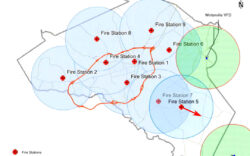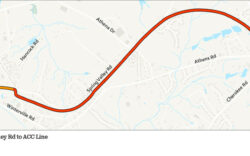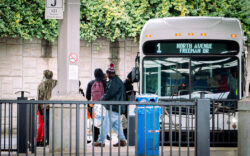Mayor Nancy Denson and Athens-Clarke County Manager Alan Reddish put the brakes on two separate proposals to make Prince Avenue safer for pedestrians last month, according to documents Flagpole obtained through an open records request.
A group of concerned citizens called Complete Streets: Prince Avenue quietly floated a plan in early February to conduct a temporary trial in April and find out once and for all whether putting the locally owned portion of Prince between Pulaski Street and Milledge Avenue on a road diet—reducing travel lanes to two and adding a center turn lane with pedestrian islands—would make it safer without snarling traffic.
Mayor Nancy Denson told a constituent Feb. 9 that she was “not opposed to the concept” but would rather do it in the fall so all stakeholders would have time to discuss it, and because elections are coming up May 20. “The discussion and decision needs to be a thorough, thoughtful community decision, which is hard to do in the heat of campaigns.”
Complete Streets: Prince Avenue founder Tony Eubanks reported on Mar. 1 that he had met with ACC Assistant Manager Blaine Williams, Transportation and Public Works Director David Clark and commissioners Kelly Girtz and Jerry NeSmith, and that they had settled on Oct. 12–31 to conduct the experiment. In-fighting among commissioners started almost immediately.
Commissioners Mike Hamby and Kathy Hoard objected that Commissioner George Maxwell, who represents part of Prince Avenue along with Girtz and Commissioner Jared Bailey, was not invited to the meeting. (Maxwell himself did not object.)
In addition, Hamby and Commissioner Andy Herod questioned the dates chosen for the pilot project, because they fell on a period with no home football games.
“If serious consideration is to be given to this, then a serious study needs to be done when traffic is at its heaviest,” Hamby wrote Mar. 1.
Herod also questioned whether Prince Avenue really deserves so much attention.
“Certainly, the folks that live along there are vociferous—which is to be commended—but I need to be convinced with traffic data that there are no other corridors/streets that are more dangerous than Prince before moving ahead with this,” he wrote. (According to data compiled by UGA, Prince has the second-most car-pedestrian collisions in Athens, behind Lumpkin Street.)
New Crosswalk?
At the same time, a separate, smaller project was getting underway. Commissioner Allison Wright submitted a formal request Mar. 6 for the ACC Transportation and Public Works Department to review the crosswalk at The Grit because “the current location is problematic.”
She noted that a large utility pole obstructs drivers’ view of pedestrians and proposed moving the crosswalk toward the Bottleworks, away from the potentially hazardous pole and curb cuts.
On Mar. 10, Commissioner Jerry NeSmith asked Clerk of Commission Jean Spratlin to broaden the request by asking TPW to “recommend more effective cross-walk signalization and an estimate of its cost,” because drivers have complained that it is “just not obvious enough.” Wright, however, raised a concern that NeSmith’s request could complicate the issue.
An unnamed TPW employee responded to Wright’s request by saying that the department has always favored the Bottleworks location Wright suggested, but the commission voted to move it 40 feet southeast to its current location in 2003, because the owner of a Curves fitness center in the Bottleworks (now closed) didn’t want it in front of that business.
“I remain perplexed as to how that property owner was able to influence it to be at this location when The Grit business owners said they thought this location was problematic,” Wright wrote.
In addition, the recent change in the one-way direction of Newton Street to run away from Prince “creates a new conflict between pedestrians and left-turning vehicles who often block the crosswalk. T&PW staff continues to believe that the original location would be preferable for the crosswalk.” Moving it would cost $10,000, and $25,000 is available for crosswalk improvements in the county’s current budget, according to TPW, and a report could have been written for the commission to discuss at its Apr. 17 agenda-setting meeting and voted on May 6.
Reddish jumped in Mar. 14, telling NeSmith that he “intervened in this latest work request because it seems to me that it goes beyond a routine work request and begins to enter the area of commissioners giving work directives to staff.” The ACC charter doesn’t allow individual commissioners to give orders to county employees.
Reddish went on to write that Prince Avenue is signaled according to state standards, with additional flashing beacons added in July 2011 that exceed those standards. He advocated for a consistent approach at the three mid-block crossings on Prince—near The Grit, Daily Groceries and Piedmont College—because studies show that drivers are more likely to stop when crosswalks all look alike.
“Therefore, I would caution against constructing radically different control devices at certain crosswalk locations and not others unless there are clearly demonstrated needs for such special control devices,” he wrote. Prince doesn’t seem to meet those criteria, with four pedestrian accidents over the past five years, according to Reddish.
Eubanks, though, noted in his Mar. 1 email that such statistics may be misleading.
“Apparently, we have a perception problem; there are those who don’t see pedestrian and bike safety as an issue,” he wrote. “We feel that collision data is underreported and obviously doesn’t include near misses.”
Reddish listed additional options for crosswalks, including an overhead flashing beacon, a high-intensity beacon, a traffic light and grade separation like a pedestrian bridge. Those options range from a few thousand dollars for the first two to more than $100,000 for the latter two.
Reddish also wrote that changing the crosswalk location in front of The Grit would require a commission vote, since the commission chose the location in the first place, and no funding for moving the crosswalk has been budgeted.
“In light of the fact that accident reports do not indicate that staff should unilaterally begin a project to increase safety and due to recent discussions concerning the future of Prince Avenue, I will not be directing staff to begin work on this project without approval of the [mayor and commission],” he wrote.
Girtz officially asked Denson on Mar. 16 to put both the crosswalk and the demonstration project on the agenda for a July 1 vote. After asking Reddish to review her response, Denson denied Girtz’s request two days later.
“Given our established policy that reconfiguring streets to three lanes be done when a street is repaved, I do not see urgency here related to a demonstration project,” Denson wrote. “The expected repaving schedule for Prince Ave. is four to five years off.”
Saying she “enthusiastically supports” pedestrian safety, though, Denson wrote that she had asked Reddish to schedule a work session June 10. The work session will include information and discussion on traffic in and around Prince, the possibility of making feeder streets one way, crosswalks, signalization options, left-turn prohibitions, accident reports, future traffic estimates, the eventual redevelopment of St. Joseph’s Catholic Church, the budget and timeline for any changes, the possibility of a bottleneck with three lanes and the possible negative impact on downtown.
Girtz wrote back that he supported the June work session but was “disappointed that you have retreated from your earlier interest in an autumn timeframe for a demonstration project. As far as the movement of the crosswalk, that was a staff recommendation that remains pertinent.
“Residents have waited over a decade for substantive improvements to the street’s safety and continue to look for action. It is important to note that GDOT is providing an analysis of the state-controlled segment of Prince this spring, to be followed by a set of recommendations. The last thing anyone would ultimately hope to see is a configuration of the local segment of the road that is less safe than the state segment due to our failure to act.” [Editor’s note: It has since been moved to fall.]
At the time, Denson did not know about the GDOT study of the state-owned portion of Prince northwest of Milledge Avenue.
“Is this something I overlooked?” she asked Reddish Mar. 19. “First I have heard about this.”
The GDOT road safety audit was requested by the alternative transportation group Georgia Bikes and will take place sometime after UGA’s fall semester starts, according to department spokeswoman Teri Pope. Engineering, enforcement, education and emergency services officials will “walk the roadway and assess its conditions, then make recommendations on improvements,” Pope said.
According to Georgia Bikes Executive Director Brent Buice, Denson called Jamie Boswell, a real estate agent whom she appointed to a Prince Avenue study committee in 2012 and who is also Athens’ representative on the GDOT board. Then Boswell called Buice wanting to know the name of the GDOT employee in charge of the “bike study,” Buice said.
Boswell told Flagpole that he supports the audit, although the GDOT board is not directly involved with it. “If there’s a safety problem, we certainly need to know about it,” he said. He personally has never had a problem crossing Prince (where his office is located) at a light, but he has heard others talk about how dangerous it is, he said.
Choosing Sides
NeSmith weighed in on Girtz’s side in his exchange with Denson. “It is well past time that Athens-Clarke County made solid plans for improving the safety and commerce of Prince Avenue,” NeSmith wrote. “I will collaborate and cooperate with Commissioner Girtz in seeking meaningful action sooner, rather than kicking the can down the road as this government has done so far.”
Bailey and Maxwell also wrote that they wanted moving the crosswalk put on the agenda. In addition, Bailey urged Denson not to delay the trial road diet. “Our citizens have been asking us to address pedestrian and bicycle safety on Prince for years now, and frankly, we should be listening to them and taking action,” he wrote.
The batch of emails Flagpole obtained included 10 letters of support for the road diet demonstration project, including one from June Ball on behalf of the Historic Cobbham Foundation, one from Avid Bookshop owner Janet Geddis and another from mayoral candidate Tim Denson. Virginia Kilmer Veale wrote that she recently came to Athens to take her daughter to a band clinic and visit her son, a UGA freshman.
“What dawned on my husband and me the most about Athens is how many hundreds of young people walk and/or ride bikes to get around,” Veale wrote. “While this, I am certain, helps alleviate the overflow of traffic, we also witnessed road rage and crowding on streets during daylight hours. Many cars were unwilling to stop and let pedestrians pass, and we were frightened more than a few times by the rate of speed cars travel in Athens.”
The only email opposing it came from Normaltown property owner Jimmy Wilfong, who simply forwarded a link to the Complete Streets: Prince Avenue website with the subject line, “this will totally screw up vehicles trying to go down prince, huge bottleneck.”
NeSmith warned Denson Mar. 20 to expect some blowback for not scheduling votes on the crosswalk and demonstration project in July: “It seems that you have changed your mind since meeting with Tony and Kelly a few weeks ago. At least that will be the perception. So be prepared for quite a stir as word of your most recent decision spreads.”
Like what you just read? Support Flagpole by making a donation today. Every dollar you give helps fund our ongoing mission to provide Athens with quality, independent journalism.









